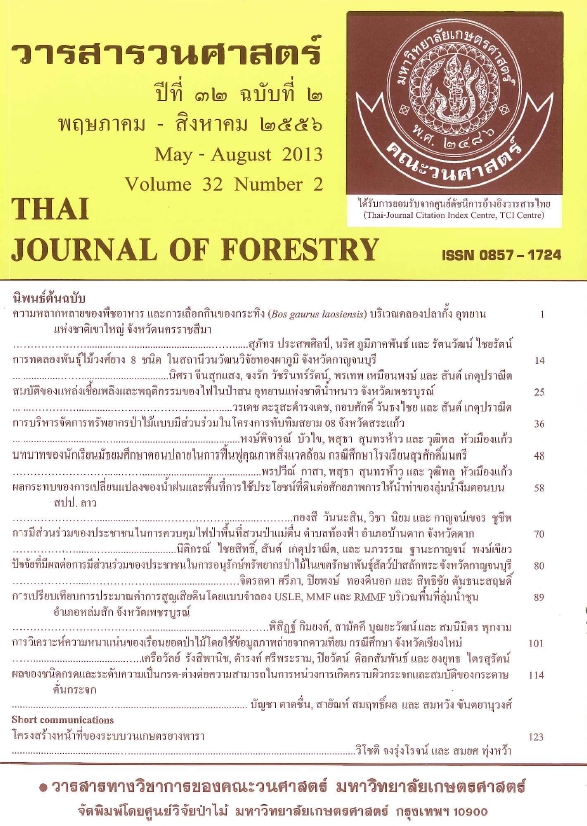สมบัติของแหล่งเชื้อเพลิงและพฤติกรรมของไฟในป่าสน อุทยานแห่งชาติน้ำหนาว จังหวัดเพชรบูรณ์
Main Article Content
บทคัดย่อ
สมบัติของแหล่งเชื้อเพลิงและพฤติกรรมไฟ ในป่าสนที่เสื่อมโทรม และในสังคมย่อยป่าสนผสมก่อ ได้ทำการศึกษาในพื้นที่อุทยานแห่งชาติน้ำหนาว จังหวัดเพชรบูรณ์ มีวัตถุประสงค์เพื่อศึกษาและเปรียบเทียบ สมบัติของแหล่งเชื้อเพลิงและพฤติกรรมไฟในสังคมพืชทั้งสองชนิด โดยวางแปลงขนาด 50x50 เมตร จำนวนสังคมพืชละ 3 แปลง สมบัติของแหล่งเชื้อเพลิงที่ทำการศึกษา ได้แก่ ปริมาณเชื้อเพลิง, ความชื้นของเชื้อเพลิง, ความสูงของเชื้อเพลิง, การปกคลุมของเชื้อเพลิง, สิ่งที่หลงเหลือหลังการเผาและเชื้อเพลิงที่ถูกเผาไหม้ ทำการบันทึกข้อมูลก่อนและหลังเผา พฤติกรรมของไฟและสภาพอากาศที่ทำการศึกษา ได้แก่ อัตราไฟลาม, ความสูงเปลวไฟ, อุณหภูมิของเปลวไฟ, ความเร็วลม อุณหภูมิอากาศและความชื้นสัมพัทธ์ ทำการบันทึกข้อมูลขณะทำการเผา ความรุนแรงของไฟ และความยาวเปลวไฟ คำนวณโดยใช้สมการของ Byram (1959) ทำการประเมินถึงระดับอันตรายของไฟเพื่อนำไปใช้ในการควบคุมไฟป่าตามวิธีการของ Andrew (1980)
ผลการศึกษา พบว่าสมบัติของแหล่งเชื้อเพลิงทั้งหมด ยกเว้นค่าเฉลี่ยปริมาณสิ่งที่หลงเหลือภายหลังการเผา ของป่าสนเสื่อมโทรมมีค่ามากกว่าในป่าสนผสมก่อ โดยค่าเฉลี่ยของปริมาณเชื้อเพลิง, ปริมาณเชื้อเพลิงที่ถูกเผาไหม้, ความชื้นเชื้อเพลิง และความสูงเชื้อเพลิง เท่ากับ 13.32 ตันต่อเฮกแตร์ 9.65 ตันต่อเฮกแตร์, ร้อยละ 87.05 และ 0.40 เมตร ตามลำดับ ค่าเฉลี่ยดังกล่าวของป่าสนผสมก่อ เท่ากับ 8.30 ตันต่อเฮกแตร์ 2.33 ตันต่อเฮกแตร์ ร้อยละ 60.82 และ 0.31 เมตร ตามลำดับ ค่าเฉลี่ยปริมาณสิ่งที่หลงเหลือภายหลังการเผาของป่าสนเสื่อมโทรม เท่ากับ 3.67 ตันต่อเฮกแตร์ ค่าเฉลี่ยดังกล่าวของป่าสนผสมก่อ เท่ากับ 5.97 ตันต่อเฮกแตร์ ประเภทเชื้อเพลิงหลักและเชื้อเพลิงรอง ของป่าสนเสื่อมโทรม คือ หญ้าและซากพืช มีร้อยละการปกคลุมของหญ้า เท่ากับ 74.85 สำหรับป่าสนผสมก่อ คือ ซากพืชและหญ้า มีร้อยละปกคลุมของซากพืช เท่ากับ 60.82 พฤติกรรมของไฟและสภาพอากาศทั้งหมด ยกเว้นความชื้นสัมพัทธ์ของป่าสนเสื่อมโทรมมีค่ามากกว่าป่าสนผสมก่อ โดยค่าเฉลี่ยของความเร็วลม อุณหภูมิอากาศ อัตราไฟลาม ความสูงเปลวไฟ ความรุนแรงของไฟ ความยาวเปลวไฟ อุณหภูมิเปลวไฟที่ ความสูง 20 และ50 เซนติเมตรเหนือพื้นดิน ของป่าสนเสื่อมโทรม เท่ากับ 3.37 กิโลเมตรต่อชั่วโมง 28.70 องศาเซลเซียส 1.89 เมตรต่อนาที 1.29 เมตร 362.62 กิโลวัตต์ต่อเมตร และ 1.20 เมตร 449.95 และ 604.93 องศาเซลเซียสตามลำดับ ค่าเฉลี่ยดังกล่าวของป่าสนผสมก่อ เท่ากับ 1.26 กิโลเมตรต่อชั่วโมง 27.17 องศาเซลเซียส 0.55 เมตรต่อนาที 0.39 เมตร 26.28 กิโลวัตต์ต่อเมตร 0.34 เมตร 301.22 และ 471.65 องศาเซลเซียส ตามลำดับ ค่าเฉลี่ยความชื้นสัมพัทธ์ของป่าสนเสื่อมโทรม เท่ากับ ร้อยละ 47.39 ค่าเฉลี่ยดังกล่าวของป่าสนผสมก่อ เท่ากับร้อยละ 53.72 ระดับอันตรายของไฟตามวิธีการควบคุมไฟป่าของ Andrew (1980) พบว่าความรุนแรงของไฟในป่าสนเสื่อมโทรมมีความรุนแรงปานกลาง ความรุนแรงของไฟในป่าสนผสมก่อมีความรุนแรงต่ำ
คำสำคัญ: ไฟป่า พฤติกรรมไฟ สมบัติของเชื้อเพลิง ป่าสนเสื่อมโทรม ป่าสนผสมก่อ
Downloads
Article Details

อนุญาตภายใต้เงื่อนไข Creative Commons Attribution-NonCommercial-NoDerivatives 4.0 International License.
ข้าพเจ้าและผู้เขียนร่วม (ถ้ามี) ขอรับรองว่า ต้นฉบับที่เสนอมานี้ยังไม่เคยได้รับการตีพิมพ์และไม่ได้อยู่ในระหว่างกระบวนการพิจารณาตีพิมพ์ลงในวารสารหรือสิ่งตีพิมพ์อื่นใด ข้าพเจ้าและผู้เขียนร่วม (ถ้ามี) ยอมรับหลักเกณฑ์และเงื่อนไขการพิจารณาต้นฉบับ ทั้งยินยอมให้กองบรรณาธิการมีสิทธิ์พิจารณาและตรวจแก้ต้นฉบับได้ตามที่เห็นสมควร พร้อมนี้ขอมอบลิขสิทธิ์ผลงานที่ได้รับการตีพิมพ์ให้แก่วารสารวนศาสตร์ คณะวนศาสตร์ มหาวิทยาลัยเกษตรศาสตร์ กรณีมีการฟ้องร้องเรื่องการละเมิดลิขสิทธิ์เกี่ยวกับภาพ กราฟ ข้อความส่วนใดส่วนหนึ่ง หรือ ข้อคิดเห็นที่ปรากฏในผลงาน ให้เป็นความรับผิดชอบของข้าพเจ้าและผู้เขียนร่วม (ถ้ามี) แต่เพียงฝ่ายเดียว และหากข้าพเจ้าและผู้เขียนร่วม (ถ้ามี) ประสงค์ถอนบทความในระหว่างกระบวนการพิจารณาของทางวารสาร ข้าพเจ้าและผู้เขียนร่วม (ถ้ามี) ยินดีรับผิดชอบค่าใช้จ่ายทั้งหมดที่เกิดขึ้นในกระบวนการพิจารณาบทความนั้น”


